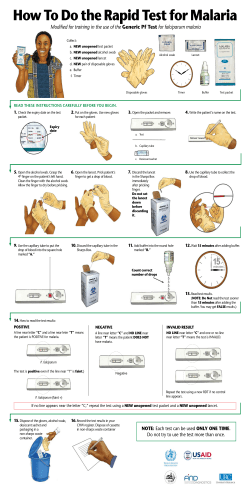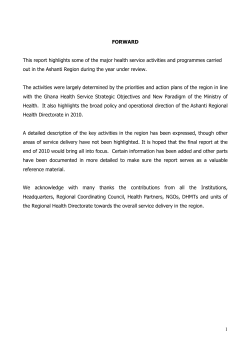
Tanzanian dance music blares from large speakers on
April 2010 • Number 25 Communication Impact: Rural communication activities increase net use in Tanzania Tanzanian dance music blares from large speakers on a flatbed truck in a rural town. An audience gathers in the village center as the roadshow begins. Dancers start dancing to draw attention of people to come and see what’s going on. After one song, the actors perform skits about the dangers of not taking children with fever quickly to the health center and the importance of sleeping under long-lasting insecticidal nets (LLINs) every night to prevent malaria. The MC explains why pregnant women must also go to antenatal clinics to get malaria prevention, and then announces a competition to see who can retreat a net the fastest, following the retreatment kit instructions. A video is projected on a big screen as the sun sets, and the participants answer quiz questions afterwards and get small prizes and flyers with more information on malaria for correct answers. These community roadshows and mobile video units are contributing to improved use of long-lasting insecticide treated nets (LLINs) in Tanzania. Background Hannah Koenker Senior Program Officer [email protected] or Marc Boulay Senior Research Officer [email protected] or Arzum, Ciloglu Senior Program Officer [email protected] Center for Communication Programs based at the Johns Hopkins Bloomberg School of Public Health 111 Market Place Suite 310 Baltimore, Maryland 21202, USA Tel: (410) 659-6300 Fax: (410) 659-6266 Website: http://www.jhuccp.org COMMIT integrates mass media and community-based activities to increase individual’s perceptions of the threat posed by malaria as well as their confidence in their ability to take actions that effectively counter this threat. Through these perceptions, the project aims to persuade households to obtain and use ITNs. Increasing perceived threat and self-efficacy The first activities to be rolled out under COMMIT were the “mid-media” activities, which included the roadshows and mobile video unit shows, implemented by PSI. These began in 2008. The community mobilization component with Community Change Agents (CCAs) followed. The CCAs worked at the community level engaging communities in group discussions, one on one house visits, cultural shows and school activities. Initial survey data were collected from Lindi and Mtwara, the first two regions in 2009, one year following the start of the community-based activities. In this survey, individuals exposed to community-level activities had greater perceptions of the threat of malaria and were more confident in their ability to obtain and use ITNs (Figure 1). Compared to the baseline survey in 2008 prior to implementation, overall perceptions of both threat and confidence had increased. Malaria causes an estimated 70,000 deaths in Tanzania each year. While the use of insecticide-treated bed nets (ITNs) can decrease the incidence of both uncomplicated and severe malaria, in 2008, only 38 percent of households in Tanzania owned at least one ITN and only 25 percent of children under five years of age slept under an ITN the night before (Tanzania Commission for AIDS, Dar es Salaam, Zanzibar AIDS Commission, National Bureau of Statistics, Dar es Salaam, Office of Chief Government Statistician, Figure 1: Average scores on perceived threat and Zanzibar and Macro International Inc. Calverton, efficacy scales, by type of exposure in 2009 Maryland, USA, 2008). The Communication and Malaria Initiative in Tanzania (COMMIT) is a five year project funded by USAID and the President’s Malaria Initiative (PMI). CCP leads COMMIT in partnership with Jhpiego, Population Services International (PSI), the Research Triangle Institute (RTI), PMI and the Tanzania Ministry of Health and National Malaria Control Program (NMCP). The program is implementing a comprehensive behavior change and communication strategy for behavior change and communication in the prevention and case management of malaria in mainland Tanzania. Specifically, COMMIT supports the NMCP Communication Strategy objectives of (1) influencing positive behavior change among target audiences through a comprehensive approach, (2) improving the flow of information to key target audiences, and (3) advocacy to raise the profile of malaria. The program conducts activities Average proportion of favorable responses To learn more contact: throughout the country with intensive community-based interpersonal communication activities in 11 of the most endemic regions in Tanzania. Perceived threat Perceived efficacy Not Exposed Exposed to roadshow or video Controlling for Age, Education, Number of Household Possessions, Currently works for money, Malaria Knowledge Scale, and Use of Media Center for Communication Programs Witte’s Expanded Parallel Process Model (Witte, 1992) posits that individuals with high perception of threat as well as high confidence will be more likely to take action to counter the threat than will individuals with high perception of threat and low confidence. Individuals who perceive low threat do not process the message any further. Consistent with theoretical predictions, perceived threat was positively associated with ITN use among individuals with high confidence and negatively associated with ITN use among individuals with low confidence (Figure 2). We see that low-efficacy households use nets less as their perceived threat of malaria increases – they are stymied by the threat and unable to act. For the high-efficacy households, their net use increases as their perception of the threat increases, but only up to a certain point. Beyond step 5 on the threat scale, net use falls off, which may indicate that the threat messages may be too fear-inducing, and could be dialed back. Reaching our audience Since 2008, COMMIT has directly reached more than 3 million people through a variety of community mobilization and outreach activities. This includes discussions and group meetings with Community Change Agents, Mobile Video Unit shows and Road Shows. All activities are focused on the main malaria messages of sleeping under ITNs, malaria in Pregnancy and under-five case management. Since the 2009 survey, more than 1,000 villagebased respected community members have been trained as community change agents (CCAs). CCAs organize and conduct interpersonal communication and facilitate educational events with community members, focusing on the importance of using ITNs, proper treatmentseeking behavior, prevention of malaria during pregnancy, and preparing communities to accept indoor residual spraying (IRS). COMMIT, together with the National Malaria Control Program established a Journalist Against Figure 2: High efficacy and low efficacy households’ net use 80 60 Low efficacy High efficacy 40 20 0 2 Next steps for assessing impact To measure the impact of these mass media and village-level communication activities, a second survey will be fielded in 2010, one year following previous survey. It will assess the combined effects of mass media and community-based activities on perceptions and use of ITNs, and offer further lessons in message development and channel selection for other malaria prevention programs. Works Cited Tanzania Commission for AIDS (TACAIDS), Zanzibar AIDS Commission (ZAC), National. (2008). Tanzania HIV/AIDS and Malaria Indicator Survey 2007-08. Dar es Salaam, Tanzania: TACAIDS, ZAC, NBS, OCGS, and Macro International Inc. 100 1 In 2010, Tanzania launched the Malaria Haikubaliki Campaign in coordination with implementing partners CCP, PSI, Malaria No More and Voices Tanzania. The campaign launch concert featured the President of Tanzania, Jakaya Kikwete, several national music stars, and highlighted the work of the Community Change Agents. COMMIT’s Malaria Haikubaliki radio campaign in 2010 will feature 16 serial PSAs and 16 “2 Minutes of Wisdom” spots that use well respected national figures to share their stories about malaria and offer sage advice. 3 5 6 Perceived threat of malaria (1=Low, 6=High) Controlling for age, education, socio-economic status, malaria knowledge, receipt of voucher, and exposure to general media, the team found that households that were exposed to the roadshows were more than twice as likely to have all of their children under five sleeping under an ITN (Figure 3). Malaria Network with a core group of print, TV, and radio journalists working together to ensure malarial is on the national and local agenda. The network will work to disseminate correct information on malaria prevention, as well as to act as a watchdog on the implementation of malaria programs in Tanzania. Figure 3: Percent of households in which all children under 5 slept under a bednet the previous night, by exposure Witte, K. (1992). Putting the fear back into fear appeals: The extended parallel process model. Communication Monograph , 59, 329-349. COMMUNICATION Summarizes research and programmatic findings from the Center for Communication Programs at the Johns Hopkins University School of Public Health. JHUCCP leads the COMMIT project, with partners Population Services International, JHPIEGO and a number of local Tanzanian NGOs. COMMIT is supported by the President’s Malaria Initiative through the United States Agency for International Development, the Centers for Disease Control and Prevention, and the Department of Health and Human Services. Not Exposed Exposed to Roadshow or Video Center for Communication Programs Communication Makes the Difference! April 2010, Number 25
© Copyright 2025





















